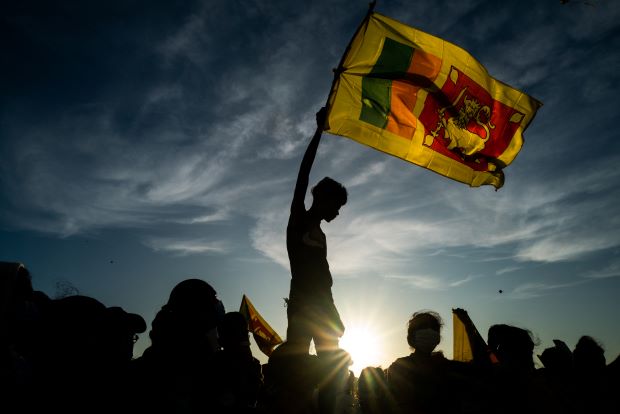A defining moment for Sri Lankan democracy
By Pakiasothy Saravanamuttu
There was a markedly different mood in the first days of Sri Lanka’s New Year this year. It was a testament to the country’s grave woes that instead of spending time with family over vast meals, tens of thousands of protesters descended onto the streets outside the Presidential Secretariat in Colombo in frustration over the political mismanagement of the worst economic crisis since independence in 1948.
For many, rising prices and stagnant wages meant they were not able to afford food to cook for the New Year festival. Widespread fuel shortages meant that there were no buses to transport them to their family villages. The nation of 22 million has been pushed to the brink and their rage is being directed against strongman President Gotabaya Rajapaksa—or ‘Gota’ as he was affectionately called. Nowadays it is more common to hear “Gotta go home” as protesters demand his resignation and the end of his family’s two decades long iron grip over the country.
The pandemic has punished Sri Lanka’s economy just as it was getting back on its feet after the 2019 Easter Sunday suicide bombings that killed over 250 people. The war in faraway Ukraine is also having an impact—the tea we export there and the tourists they export here have come to an abrupt halt. Power cuts, medicine shortages and absence of essential goods are the norm across Sri Lanka.
But despite events beyond our control, the main source of the misery is misgovernance. Tax cuts, profligate spending, the printing of money and the installation of cronies, technocrats and military officers to key positions are among a litany of blunders that have brought the country to its knees. A stubborn refusal to seek support from the International Monetary Fund (IMF) until the last minute wasted precious time. Sri Lanka is now defaulting on its $51 billion foreign debt. We have moved from being the Greece of South Asia to its Lebanon.
But the fundamental causes run deeper than the last few years. The corruption, nationalism and authoritarianism of the Rajapaksa administration is well documented. Investigations into credible allegations of Rajapaksa’s war crimes against the Tamils during the country’s two and half decade civil have been constantly dismissed. And now ordinary Sri Lankans, staring starvation in the face while the elite grow fat, have had enough. The regime must fall. The only question is how.
Newly appointed Sri Lankan finance minister Ali Sabry (replacing Basil Rajapaksa, the brother of the president) was in Washington recently to negotiate with the IMF over bridging finance and a hefty bailout. To get the best possible terms, the IMF must be able to deal with a stable and competent government, which Sri Lanka does not have. Whatever the outcome, there will be a period of unforeseen serious financial hardship for Sri Lanka. If no opposition parties or protesters accept the credibility of a government announcing severe belt-tightening, then protests are only going to swell.
Though the IMF cannot publicly condemn the Rajapaksa regime, they could creatively convey their concerns. In any aspirant democracy it is fundamental to maintain strong institutions, good governance and checks and balances such as independent commissions and oversight committees. If the IMF robustly reminded Minister Sabry of these crucial tenets, it would be a message heard loud and clear by the thousands at Sri Lanka’s barricades. The breadth of opposition to Rajapaksa is unusual: Less than two years ago he secured a two-thirds majority in Parliament. The protesters now are from the grassroots: youth-led, multi-generational and from a spectrum of backgrounds spanning the Sinhala, Tamil and Muslim communities. They have peacefully harnessed public anger. Now is the time for it to be channelled into effective action.
According to the Constitution, a presidential election can be held in 2023 if Rajapaksa decides to stand for a second term. Impeachment is possible, though complicated, lengthy and far from guaranteed. But if sustained peaceful protest forced Rajapaksa’s resignation, Parliament could appoint his interim successor quickly, tie together the IMF agreement and swiftly hold an election. We can only hope that the opposition can get their house in order, park their personal ambitions and sing from the same hymn sheet to upgrade the country from a Rajapaksa family business and piggy bank.
We all know that Rajapaksa cannot go quietly. His raison d’etre is the maintenance of power and leaving political office would potentially expose him to prosecution for his extensive misdeeds. Therefore, protesters must be prepared for Rajapaksa to order violent repression from his security forces or use saboteurs to discredit the movement. If the worst-case scenario happens, the international community must be prepared to isolate the regime as much as possible—in the current spirit of defending democracy. Sri Lanka’s main backer India, and to a lesser extent China, will not let the country collapse, but how long can they continue to prop up the very cause of the impending collapse? The coming days could define Sri Lanka’s future. We ignore it at our peril.
-Dr. Pakiasothy Saravanamuttu is the executive director of the Centre for Policy Alternatives and a civil society IMF fellow and this article was originally featured on newsweek.com


